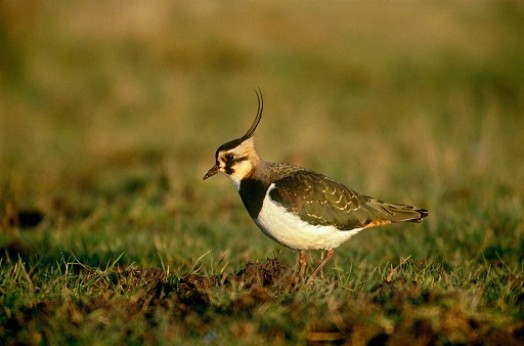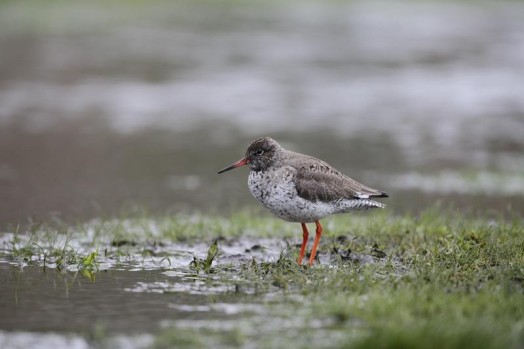Supporting guidance for Wader Grazed Grassland
This is an old version of the page
Date published: 2 February, 2021
Date superseded: 13 January, 2022
For recent changes to this guidance, please see the bottom of the page.
To see recent changes to this guidance, check the bottom of this page.
Introduction
The wader group includes birds such as oystercatcher, lapwing, redshank, curlew and snipe. To survive and breed successfully, waders need:
- a safe nesting site. Most waders nest in short or structurally diverse grassland
- an abundance of soil and ground insects
- damp or wet feeding areas, especially for chicks

Lapwing – Credit: Chris Gomersall – © RSPB images
The Wader Grazed Grassland option aims to provide nesting and feeding opportunities for waders. The timing and intensity of grazing determines the structure and plant composition of the sward, which in turn influences insect numbers and bird usage.
Patchy swards, which vary in height, provide suitable feeding and nesting habitat. Short grazed areas (less than 10 centimetres) provide easy access to food and open terrain to enable vigilance against predators. Taller vegetation allows nesting birds and chicks to conceal themselves, and generally supports more insects and other wildlife.

Redshank – Credit: Andy Hall – © RSPB images
What needs to be done
Excluding or restricting livestock numbers and avoiding mechanical operations (such as fertiliser spreading, harrowing, rolling and topping) during the breeding season will help improve wader breeding success.
Grazing is required outside the exclusion / restriction period to maintain a suitable sward for nesting in the following season.
Which fields to choose
Fields which contain boggy areas and wet flushes are more likely to remain damp into June. These should be prioritised as they provide ideal nesting sites and food-rich areas for adults and chicks.
Fields can be enhanced by creating wader scrapes to increase food availability during the summer months. See the Creation of Wader Scrapes capital item for more details.
Waders are more likely to select unimproved or semi-improved grasslands than improved grasslands. The area of ground submitted for the option should be at least one hectare, although areas greater than three hectares that may cross field boundaries and are without boundary features will be of more benefit, especially on larger farms.
Research has shown that waders avoid nesting and feeding in areas close to tall trees and hedges. Therefore you should keep the managed area at least 30 metres from any line or group of trees or hedgerows, and you should not plant new hedges between fields entered into this management option.
Note:
Although it is not an eligibility requirement that the Wader Grazed Grassland option cannot be adopted within 30m of a hedgerow, trees or woodland, this is best practice. Where you choose to include a 30m buffer it must be clearly shown on the management map with the width labelled. If your application is successful the area to be claimed in the contract for this option will be minus the buffer.
In 2021, scoring for Vulnerable Priority Species (VPS) wader applications will reward applications that offer management in fields that best suit wader requirements. Further detail is provided in the scoring section.
Rushes are common in wet areas, and will often require annual management. Scattered rushes provide adults and chicks with protection from the elements, nesting sites and cover from predators. However, waders also need short, open areas for their chicks to walk through and so they can see approaching predators. Therefore heavy infestations of rush or thatched vegetation tend to be avoided.
Knowing if you have 'too much' rush and what the 'right amount' of rush is will depend on the species you are managing for – the RSPB’s advisory leaflets provide detailed information on the needs of each species.
It is worth bearing in mind that sward and water level variations across larger fields means that you can often create conditions for more than one species.
Payments are available through the Cutting of Rush Pasture capital item for areas needing control. Note, however, that control methods and timings will need to be planned to meet the requirements of the Wader Grazed Grassland option.
Further information
Different species of waders have differing habitat preferences, particularly relating to sward height, structure and soil dampness. Therefore, if you are considering this option, you need to understand the habitat requirements of the particular species you have on your land, and how you can best manage your land to conserve them.
Further advice on four common farmland waders is available at the following links:
The integration of grazing management with other options, such as Wader and Wildlife Mown Grassland,and capital items such as Creation of Wader Scrapesmay well be appropriate.
Getting advice
There are a number of wader-focused projects whose staff will be able to provide advice on waders and their management. To find your local advisor, contact your local NatureScot office.
Recent changes
| Section | Change | Previous text | New text |
|---|---|---|---|
| Introduction | Criteria extended |
• safe nesting site. Most waders nest in short or structurally diverse grassland • an abundance of soil and ground insects |
• safe nesting site. Most waders nest in short or structurally diverse grassland • an abundance of soil and ground insects • damp or wet feeding areas, especially for chicks |
| Which fields to choose | Amendments to the guidance – minimum area | Waders are more likely to select unimproved or semi-improved grasslands than improved grasslands. The area of ground submitted for the option should be at least 3 hectares and this may cross field boundaries. | Waders are more likely to select unimproved or semi-improved grasslands than improved grasslands. The area of ground submitted for the option should be at least one hectare, although areas greater than three hectares that may cross field boundaries and are without boundary features will be of more benefit, especially on larger farms. |
| Amendments to the guidance – trees and hedges | Research has shown that waders avoid nesting and feeding in areas close to tall trees and hedges. Therefore you should keep the managed area at least 30 metres from any line or group of trees or hedgerows. | Research has shown that waders avoid nesting and feeding in areas close to tall trees and hedges. Therefore you should keep the managed area at least 30 metres from any line or group of trees or hedgerows and you should not plant new hedges between fields entered into this management option. | |
| Amendments to the guidance – rushes | Rushes are a common problem in wet areas, and heavy infestations can have an adverse effect on the value of the grassland. Payments are available through capital items for areas needing control. Note, however, that control methods and timings will need to be planned to meet the requirements of the Wader Grazed Grassland option. |
Rushes are common in wet areas, and will often require annual management. Scattered rushes provide adults and chicks with protection from the elements, nesting sites and cover from predators. However, waders also need short, open areas for their chicks to walk through and so they can see approaching predators. Therefore heavy infestations of rush or thatched vegetation tend to be avoided. Knowing if you have 'too much' rush and what the 'right amount' of rush is will depend on the species you are managing for – the RSPB’s advisory leaflets provide detailed information on the needs of each species. It is worth bearing in mind that sward and water level variations across larger fields means that you can often create conditions for more than one species. Payments are available through the Cutting of Rush Pasture capital item for areas needing control. Note, however, that control methods and timings will need to be planned to meet the requirements of the Wader Grazed Grassland option. | |
| Further information | Different species of waders have different management needs, in addition to grazing management. For this reason, implementation of this option alone is unlikely to benefit the birds. Therefore, if you are considering this option, we recommend you consider the particular species you intend to manage and any additional measures they may require. | Different species of waders have differing habitat preferences, particularly relating to sward height, structure and soil dampness. Therefore, if you are considering this option, you need to understand the habitat requirements of the particular species you have on your land, and how you can best manage your land to conserve them. | |
| Managing grassland for waders (new RSPB leaflet) |
Previous versions
Previous versions
Download guidance
Click 'Download this page' to create a printable version of this guidance you can save or print out.
